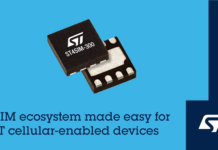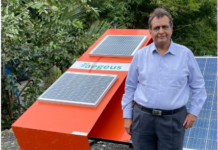
The future of communications may be 5G, where mobile networks push bandwidth-heavy video to phones and pull data from self-driving cars, but some firms see an alternative: farm irrigation equipment, donation boxes and oysters, connected by a technology called LoRa.
LoRa (for Long Range) is among a clutch of narrowband technologies that connect devices cheaply over unlicensed spectrum and vast distances, needing very little power.
The catch: they can only send small parcels of data rather than the gigabytes most wired and mobile standards aspire to. But, advocates say, that may be more than enough.
“It turns out you don’t need that huge an infrastructure, and it can be driven by small devices that are very smart and not very expensive,” says Mike Cruse, CEO of Definium Technologies, which is building LoRa-based devices for farmers, universities and mines.
The so-called Internet of Things (IoT) has long promised to hook up devices, from aircraft to hairdryers, enabling owners to monitor, control and collect data from them remotely. Spending on the IoT will hit $6 trillion between 2015 and 2020, according to PricewaterhouseCoopers.
But the reality has been slow catching up. Ericsson this year almost halved the number of connected devices – including smartphones – it sees by 2020 to 28 billion.
Part of what’s holding things back, critics say, is that solutions are too expensive and elaborate for what is needed. Most involve cellular connections, which are either impractical in rural areas or beyond a user’s budget.
Take Richard Gardner, who runs a 2,500 hectare (6,178 acre) farm in Tasmania and pays A$1,200 per sensor for a cellular-based soil moisture measuring system. He’s working with Definium to design one costing a tenth of that.
“There’s a lot of technology out there that works now, it’s just very expensive. We’ve got something now that we think has better attributes and is cheaper,” says Gardner, who has invested in Definium and says he already has other farmers keen to buy the company’s products.
LORA AND FRIENDS
Making all this possible is LoRa, a narrowband standard adopted by the likes of Cisco and IBM, where the thumbnail-sized radios that send and receive data sell for a dollar or less.
Dutch enthusiasts are building a global community of open-source LoRa gateways, called the Things Network. Nodes send and receive messages – about a tenth of the size of an SMS – every couple of minutes to once every few hours. Followers have rolled out their own experimental networks using the community’s software in cities from Colombia to Russia.
Founder Wienke Giezeman says a $300 gateway – the router connecting the LoRa nodes to the Internet – will be available next month. Half a dozen would be enough to cover an average-sized city. “This,” he says, “is going to push the next phase of growth.” And LoRa isn’t the only narrowband technology in town.
Weightless, a British-based alliance, is one. Another is a proprietary US technology run by a company called Ingenu, as is Sigfox, a French firm, which has raised $150 million from companies including Samsung Electronics.
POTENTIAL LOSERS
The biggest potential losers are the telecoms companies, the traditional gatekeepers to the coverage these networks now claim. Ericsson says only 1.5 billion of the 16 billion IoT devices it reckons will be connected in 2021 will rely on cellular networks.
Some telecoms firms are counting on NB-IOT, a narrowband standard adopted by the industry that would use their existing cellular networks. Others are hedging their bets by building LoRa and other narrowband networks.
SK Telecom , for example, has rolled out a network across South Korea which it said would cost users a tenth of what they would pay to attach devices to its 4G network. Lagging, however, is how best to use these networks.
Charles Anderson, an analyst at IDC, says governments and companies are still pondering what might work, and what end users might want.
In the meantime, smaller players are feeling their way. One visitor to a booth at a recent IoT show in Singapore suggested connecting donation collection boxes so she’d know when they need emptying.
Rishabh Chauhan of The Things Network says the community is still experimenting – from remotely monitoring mousetraps to whether moored rowboats have filled with water. “It seems people have a use case, but want to see it on a small level. They’re still prototyping,” he said.
CITY LIMITS
Much of the pioneering work is outside cities, where existing networks are poor.
Gardner, the farmer, for example, sees the potential for monitoring water flow and levels, the voltage in his electric fences, or his crop sprinklers. Knowing whether they’re working properly would save two trips a day and cut fuel bills, he says.
In a back-room lab, Definium’s Cruse shows some of the sensors he’s designing for clients, all of which could easily connect to a LoRa network.
They include one for measuring salt levels for shrimp farmers in Bangladesh; an LED street lamp for a mining company that could be controlled remotely; a squirrel trap which would alert a catch, and a biosensor attached to an oyster to gauge its health.


















